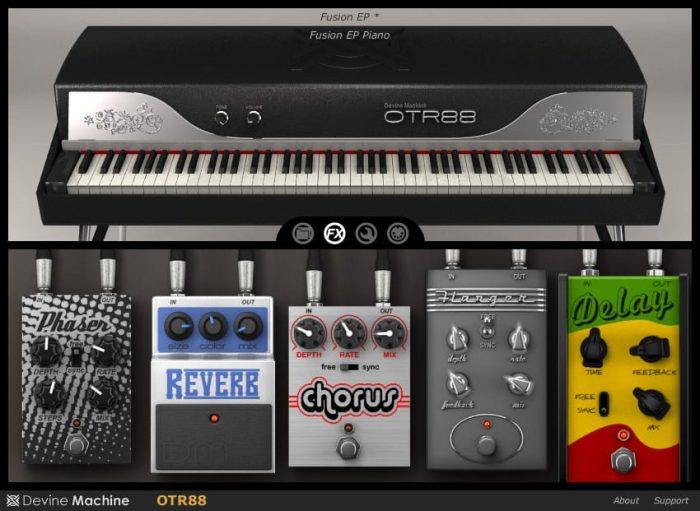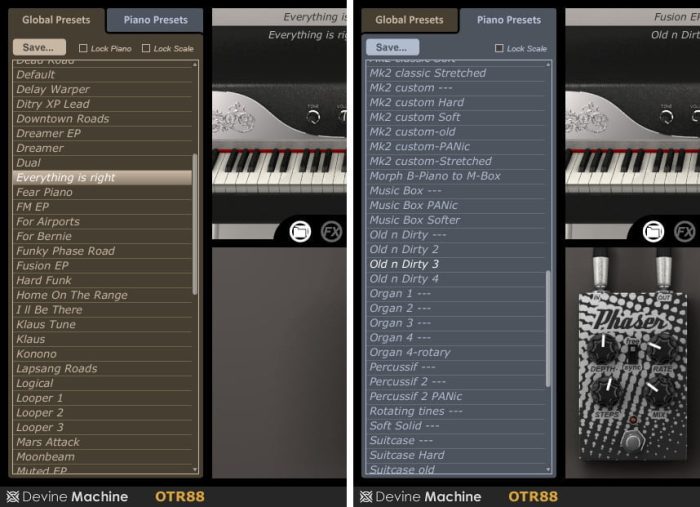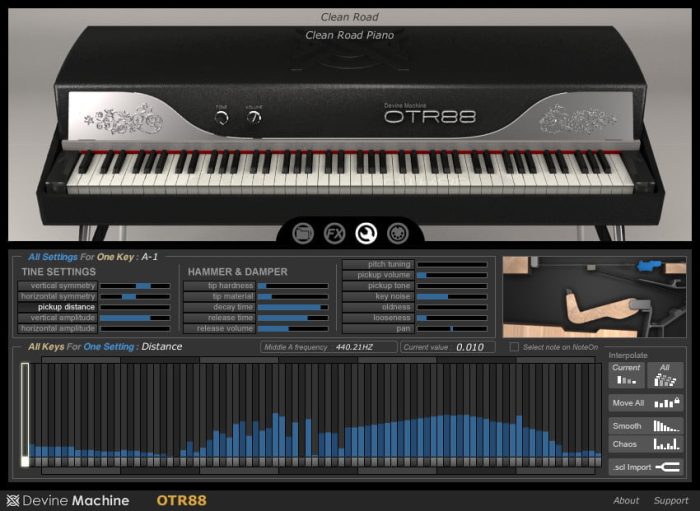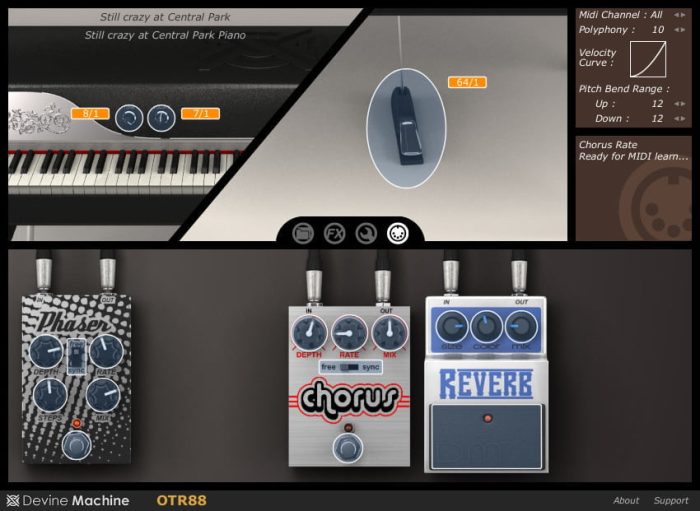The electric piano is one of my favorite instruments and I regularly use virtual electric pianos in my music, as I love the expressive character of this instrument. My EP arsenal includes both sample based instruments and physically modeled instruments, with the excellent MrRay series and the Lounge Lizard EP-3 being my most frequently used weapons of choice.
Devine Machine’s recently released OTR88 is an electric piano instrument created with physical modeling based on reaction.
Now I know that there are quite a few people out there that will tell you that these physical models are nowhere near the real thing. I am not terribly familiar with the real thing (I unfortunately don’t own one), so I can’t argue with that, but they are probably right. So, going into this review, know that I am not comparing the OTR88 to a proper electric piano.
Anyway, Devine Machine likens this new way of physical modeling to 3D, as compared to sampling being photography, and traditional additive synthesis physical modeling being like painting.
3D can be very realistic and lets you change any aspect but requires more programming and computation.
Before we take a closer look at OTR88, here’s a list of key features.
OTR88 features
- Powerful physical modeling for the most authentic electric piano sounds.
- “Per key settings” concept makes keyboard instruments completely customisable.
- Intuitive effect management to let you configure easily your post processing chain.
- 7 high quality vintage stereo effects.
- User friendly slick interface that gives you the most efficient access to every parameter.
- Full automation to take full control of any global parameters from any midi controller.
- Midi learn.
- Preset Manager (Legato, Mono, Unison, 16 voice polyphony).
First impression
OTR88’s user interface is clean and intuitive. It’s quite easy on the eyes as well. Nice looking piano in the top, a lovely collection of stomp boxes in the bottom, and a small icon bar in the middle for selecting the various screens.
The first icon in the center of the screen represents the preset manager. OTR88 knows two kinds of presets:
- Piano, only handles piano related parameters.
- Preset, includes all settings of the piano and effects.
I quite like this idea as you can now combine effect settings you like in one preset, with the characteristics of another piano model.
The various presets include the more traditional Rhodes and Wurli type sounds, as well as extreme variations with effects you might not expect from an electric piano.
To spice up the sound there are 7 effect stomp boxes available: tremolo, phaser, flanger, distortion, wah pedal, reverb, chorus, and delay. These effects can easily be inserted in the bottom of the screen and moving them around will change the effect chain in real-time, so you can audition the result instantly.
To get an idea of what OTR88 can sound like, check this Sleepless demo song. You’ll hear a few different patches being played.
So what about that physical modeling?
With physical modeling, an instrument is basically reproduced with virtual counterparts you would find in a real model. Let’s open the piano up and see what is in it.
The OTR88 uses the following parameters for its tone production:
- Vertical and horizontal symmetry of the tines, to set the position of the tines.
- Vertical and horizontal amplitude, controls the movement of struck tines.
- Pickup distance and volume, sets the distance and output volume of the electromagnetic pickups. A pickup tone control allows for cutting low frequencies.
- Hammer/Damper settings: tip hardness and material for adding harmonic tones, decay and release times and release volume, to determine the way a sound fades out.
- Pitch tuning, lets you (de)tune each key, including support of scala (scl) files.
- Key noise, Oldness – stronger envelope attack for more “bark”, Looseness – tremolo type of modulation, and Pan for panning of individual keys or the complete range.
OTR88 allows for the parameters to be set individually for each of the 88 keys. A handy toolbox allows you to manually set parameters and quickly edit settings across the keyboard with interpolate, smooth and chaos tools.
The obvious advantage of having all these parameters is that you can really do a lot of tweaking to get the exact sound you want.
Controlling the electric piano
You could program your electric piano score entirely on the computer, but it’s likely you will be using a MIDI controller keyboard to play the instrument. The last screen in OTR88 features MIDI and automation settings.
Here you can set some basic things like the MIDI port, polyphony, pitch bend range, and the velocity curve.
MIDI learn is simple. Just click the knob/parameters you want to control, adjust the knob or slider on your MIDI controller and you’re done.
You can also group parameters and assign them to one MIDI control, allowing you to change multiple parameters with the turn of one knob.
So what do I think?
Well, I’m not exactly sure what to think of OTR88. I feel it has great potential, but somehow something is lacking. For one, the included presets didn’t speak to me all that much. Sure there are plenty of them, but I would rather have just a few I really like than lots of OK ones. Some are too loud (and I mean way too loud), others too… weird I guess.
OTR88’s physical modeling may be new but for traditional Rhodes/Wurli type sounds that doesn’t necessarily mean better. I don’t have a real model to compare it too, but when comparing it to other physical models and sample based instruments, the OTR88 seems to lack a little in authenticity. I’m just not getting that vibe that I am generally looking for in an EP. Perhaps I just need to look beyond the presets and spend more time with the advanced piano controls.
So is it all bad? I guess that depends on what you are expecting from this instrument. OTR88 is probably not the best choice when looking for the most realistic emulation of a Rhodes, but if you like to have a wide range of sounds – not limited to traditional EP, OTR88 sure has a lot to offer.
I really do like the advanced tonal control with per-key-settings and chaos button (loving that random touch), and the GUI looks lovely and is easy to use.
For 229 EUR (the price of OTR88) there are quite a few products to consider. Scrabee’s Vintage Keyboard Collection, Lounge Lizard EP-3, the relatively cheap MrRay series plug-ins…
It really depends on the type of sound you are after so I recommend you do check the demo version and see what you think.
OTR88 is available for Windows and Mac (VST/AU/RTAS) for 229 EUR, optionally payable in 6 or 12 month terms.
More information on OTR88 can be found on the product page.







